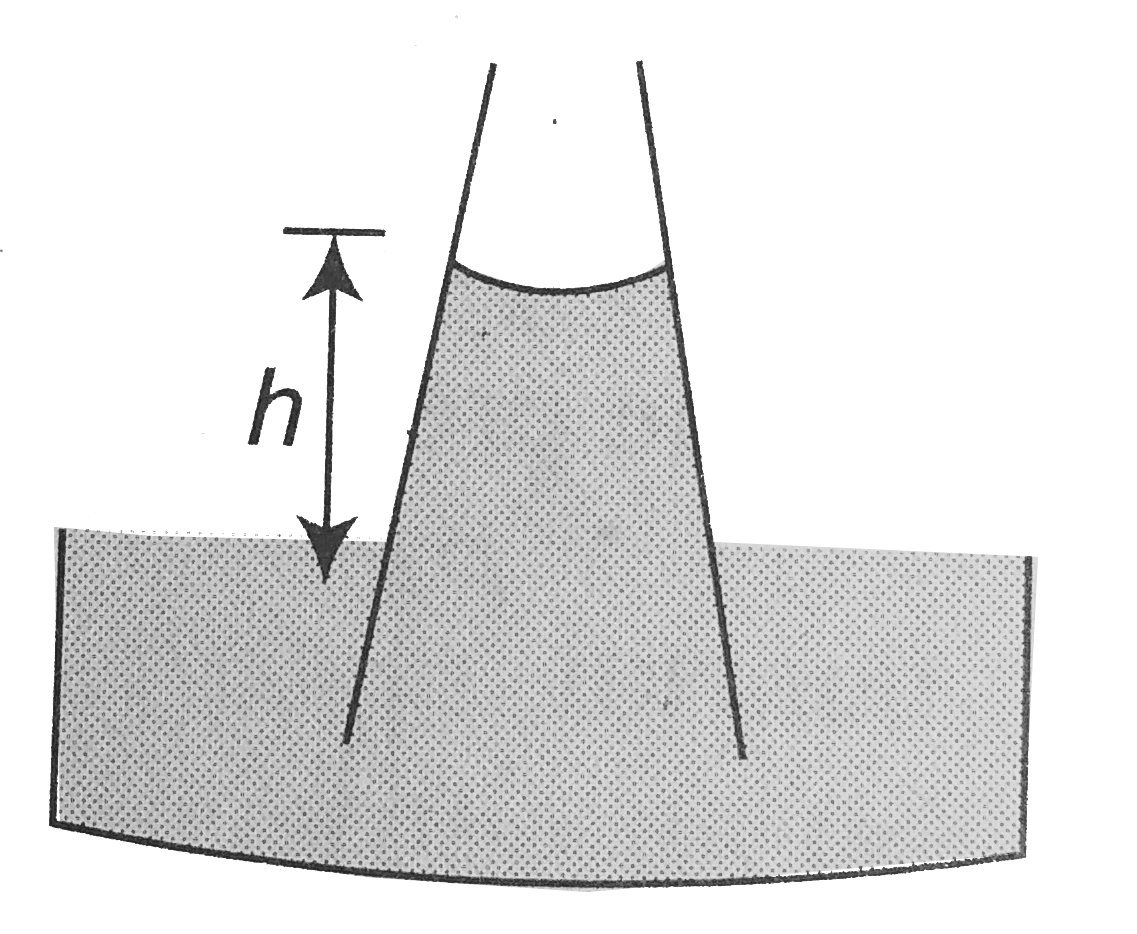Surface tension arises from the cohesive force between the surface molecules. Interplay between cohesion and adhesion force make the surface inclined at acute or obtuse angle with the contacting solid surfaces. This causes a capillary rise (or fail) given as h=2Tcosθρgr, where θ= angle of contact T= surface tension ρ= density of the liquid, g= acceleration due to gravity and r= radius of the capillary tube.
In capillary rise:
heat is evolved
Ugr decrease
Utotal increase
heat is absorbed
The correct Answer is:A
Work done by surface tension is greater than that of gravity hence heat evolved.
Topper's Solved these Questions
- BOOK - NARAYNACHAPTER - MECHANICAL PROPERTIES OF FLUIDSEXERCISE - Paragraph Type Questions5videos
MECHANICAL PROPERTIES OF FLUIDS
- BOOK - NARAYNACHAPTER - MECHANICAL PROPERTIES OF FLUIDSEXERCISE - Single Answer Questions108videos
MECHANICAL PROPERTIES OF FLUIDS
- BOOK - NARAYNACHAPTER - MECHANICAL PROPERTIES OF FLUIDSEXERCISE - More Than One Alternative Type Question32videos
MECHANICAL PROPERTIES OF FLUIDS
- BOOK - NARAYNACHAPTER - MATHEMATICAL REVIEW & PHYSICAL WORLDEXERCISE - C.U.Q13videos
MATHEMATICAL REVIEW & PHYSICAL WORLD
- BOOK - NARAYNACHAPTER - MECHANICAL PROPERTIES OF SOLIDSEXERCISE - LEVEL-II (H.W)24videos
MECHANICAL PROPERTIES OF SOLIDS
Similar Questions
Knowledge Check
- Question 1 - Select One
Surface tension arises from the cohesive force between the surface molecules. Interplay between cohesion and adhesion force make the surface inclined at acute or obtuse angle with the contacting solid surfaces. This causes a capillary rise (or fail) given as h=2Tcosθρgr, where θ= angle of contact T= surface tension ρ= density of the liquid, g= acceleration due to gravity and r= radius of the capillary tube.
Q. In capillary action θ can be:A0∘B90∘C90∘<θ<180∘Dall of these - Question 2 - Select One
Surface tension arises from the cohesive force between the surface molecules. Interplay between cohesion and adhesion force make the surface inclined at acute or obtuse angle with the contacting solid surfaces. This causes a capillary rise (or fail) given as h=2Tcosθρgr, where θ= angle of contact T= surface tension ρ= density of the liquid, g= acceleration due to gravity and r= radius of the capillary tube.
Q. If the vessel accelerates up, capillary rise,AincreasesBdecreasesCremains the sameDbecomes zero - Question 3 - Select One
The potential energy of the liquid of surface tension T and density ρ that rises into the capillary tube is
Aπ2T2ρ2gB4πT2ρ2gC2πT2ρgDπT2ρg
Given as : h=2Scosθrρg where S is the surface tension of liquid, r is the radius of capillary tube. ρ is the density and g is acceleration due to gravity then dimensional formula for S is:
View SolutionIf the cohesive force is greater than the adhesive force , the liquid surface will be
View SolutionStatement I: More is the cohesive force, more is the surface tension.
Statement II: More cohesive force leads to more shrinking of liquid surface.View SolutionPure water rises in a capillary tube upto a height of 8 cm . If surface tension of water and acceleration due to gravity are 80 dyne/cm and 1000 cm/s2 respectively , then the radius of capillary tube will be
View Solution
A capillary of the shape as shown is dipped in a liquid. Contact angle between the liquid and the capillary is 0∘ and effect of liquid inside the mexiscus is to be neglected. T is surface tension of the liquid, r is radius of the meniscus, g is acceleration due to gravity and ρ is density of the liquid then height h in equilibrium is:View Solution

